Related Research Articles
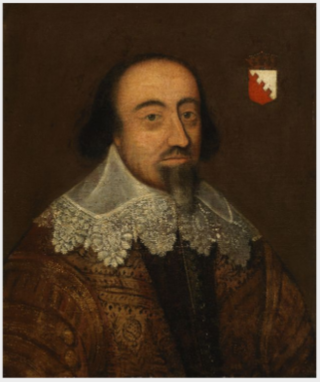
Richard Boyle, 1st Earl of Cork, also known as the Great Earl of Cork, was an English politician who served as Lord Treasurer of the Kingdom of Ireland.

The Solicitor-General for Ireland was the holder of an Irish and then United Kingdom government office. The holder was a deputy to the Attorney-General for Ireland, and advised the Crown on Irish legal matters. On rare occasions, there was also a Deputy Attorney-General, who was distinct from the Solicitor-General. At least two holders of the office, Patrick Barnewall (1534–1550) and Sir Roger Wilbraham (1586-1603), played a leading role in Government, although in Barnewall's case, this may be partly because he was also King's Serjeant. As with the Solicitor General for England and Wales, the Solicitor-General for Ireland was usually a barrister rather than a solicitor.

Plantations in 16th- and 17th-century Ireland involved the confiscation of Irish-owned land by the English Crown and the colonisation of this land with settlers from Great Britain. The Crown saw the plantations as a means of controlling, anglicising and 'civilising' Gaelic Ireland. The main plantations took place from the 1550s to the 1620s, the biggest of which was the plantation of Ulster. The plantations led to the founding of many towns, massive demographic, cultural and economic changes, changes in land ownership and the landscape, and also to centuries of ethnic and sectarian conflict. They took place before and during the earliest English colonisation of the Americas, and a group known as the West Country Men were involved in both Irish and American colonization.
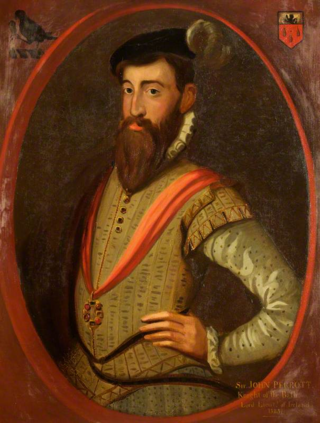
Sir John Perrot served as lord deputy to Queen Elizabeth I of England during the Tudor conquest of Ireland. It was formerly speculated that he was an illegitimate son of Henry VIII, though the idea is rejected by modern historians.
Sir John Perrot, was a figure of unusual power and influence in Tudor Britain and Ireland. Born near Haverfordwest in 1528, he inherited wealth and power – the Perrots had been accumulating both in west Wales for centuries – and gained more ingratiating himself with the English court.
His own son described him as a "very cholericke" man, who "could not brooke any crosses". He had already gathered many offices by the time he was sent to Ireland in 1571 as President of Munster to suppress a rebellion. His methods were characteristically violent – he hanged over 800 of the rebels – but he resigned after two years, having failed in his mission.
Back in west Wales he contented himself with self-enrichment and self-glorification, rebuilding in grand style his two main homes, Carew Castle and Laugharne Castle. He returned to Ireland as 1584 as Lord Deputy, with the task of crushing the Irish and colonising their land. Again unsuccessful, he returned, was falsely accused of treason by his many enemies, and died in the Tower of London in 1592, possibly of poisoning.
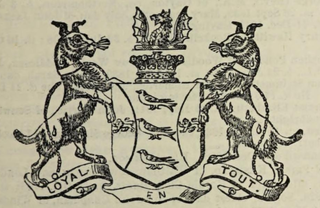
Sir Valentine Browne, of Croft, Lincolnshire, was auditor, treasurer and victualler of Berwick-upon-Tweed. He acquired large estates in Ireland during the Plantation of Munster, in particular the seignory of Molahiffe. He lived at Ross Castle near Killarney, County Kerry. He was MP in three English and one Irish parliaments.
Sir Nicholas Malby (1530?–1584) was an English soldier active in Ireland, Lord President of Connaught from 1579 to 1581.
Sir William Herbert was a Welsh colonist in Ireland, author and Member of Parliament.
Sir Charles Calthorpe (c.1540–1616) was an English-born Crown official and judge in Elizabethan and Jacobean Ireland. Prior to his appointment to the Irish High Court in 1606, he had been Attorney General for Ireland for more than 20 years, despite frequent criticisms of his professional incompetence. He was a close political associate of the Lord Deputy of Ireland, Sir John Perrot: Perrot's downfall damaged his career, but he was eventually restored to royal favour.
Nicholas Nugent was an Anglo-Irish judge, who was hanged for treason by the government that appointed him. He had, before his downfall, enjoyed a highly successful career, holding office as Solicitor General for Ireland, Baron of the Irish Court of Exchequer, and Chief Justice of the Irish Common Pleas, but he was ruined by the rebellion of his nephew William Nugent, which he was accused of supporting.
Sir Lucas Dillon, also called Luke, was a leading Irish barrister and judge of the Elizabethan era who held the offices of Attorney General for Ireland and Chief Baron of the Irish Exchequer. He supported the Lord Deputy Henry Sidney in the cess controversy and the Lord Deputy John Perrot in the Desmond Rebellions. He was held in high regard by Queen Elizabeth, but was accused by his enemies of corruption and maladministration.
Sir James Dowdall was an Irish judge of the Elizabethan era who briefly held office as Lord Chief Justice of Ireland. He should not be confused with James Dowdall, the Catholic martyr, who was his cousin.
Richard Becon or Beacon, was an English administrator and Law Officer in Ireland. He was also a political author, best known for his pamphlet Solon his follie, on the government of Ireland.
Edward Fitz-Symon was a leading Irish barrister and judge of the Elizabethan era. He held the offices of Attorney General for Ireland, Serjeant-at-law (Ireland) and very briefly Master of the Rolls in Ireland. Despite his appointment to these senior offices, he was derided by his contemporaries as being a man of "mean learning". His family were Lords of the Manor of Baldoyle for several generations.

The Court of Castle Chamber was an Irish court of special jurisdiction which operated in the sixteenth and seventeenth centuries.
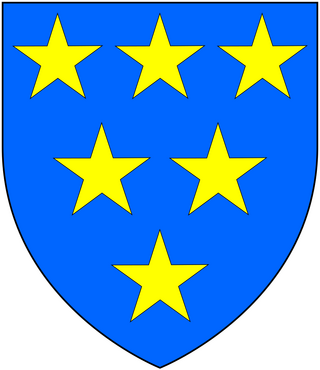
Sir Nicholas Walsh (1542–1615) was an Irish judge, politician and landowner of the late Tudor and early Stuart era. He was Speaker of the Irish House of Commons in the Parliament of 1585–86 and a close ally of the Lord Deputy of Ireland, Sir John Perrot. Perrot's downfall did some short-term damage to Walsh's career, but he soon regained his influence, as he was noted for his loyalty to the English Crown.
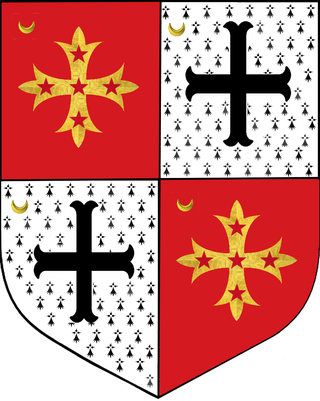
Sir Henry Ughtred or Oughtred was a merchant and shipbuilder during the reign of Elizabeth I. One of his ships, the Leicester sailed with Sir Francis Drake against the Spanish Armada. He was elected MP for the seat of Marlborough in 1584 and of Great Bedwyn in 1589. A wealthy landowner, Ughtred played an active role in the Plantations of Ireland and was knighted by the Lord Deputy in 1593. He was the son of Sir Anthony Ughtred and Elizabeth Seymour, sister to Jane, the third wife of Henry VIII. Sometime after 1557 he married Elizabeth, widow of Sir William Courtenay and daughter of John Paulet, 2nd Marquess of Winchester.
Richard Bellings or Bellyngs was an Irish barrister and landowner who was Solicitor General for Ireland from 1574 to 1584. His grandson and namesake Richard Bellings was a leading figure in Confederate Ireland, which effectively governed much of Ireland in the 1640s.
William Saxey or Saxei was an English-born judge in Ireland of the late Elizabethan and early Stuart era. He was an unpopular and controversial figure with a reputation for corruption and misanthropy.
The chief justice of Munster was the senior of the two judges who assisted the Lord President of Munster in judicial matters. Despite his title of Chief Justice, full judicial authority was vested in the lord president, who had "power to hear and determine at his discretion all manner of complaints in any part of the province of Munster", and also had powers to hold commissions of oyer and terminer and gaol delivery.
Richard Finglas was an Irish barrister and Law Officer of the sixteenth century.
References
- 1 2 3 4 Smyth, Constantine Joseph Chronicle of the Law Officers of Ireland Butterworths London 1839 p.174
- ↑ Smythes to Walsingham 31 October 1584 Calendar of State Papers Relating to Ireland of the reign of Elizabeth 1574-1585 Public Record Office
- 1 2 3 Crawford, Jon G. A Star Chamber Court in Ireland- the Court of Castle Chamber 1571-1641 Four Courts Press Dublin 2005 p.460
- ↑ Kieman, Ben Blood and Soil- Modern Genocide 1500-2000 Harrisburg 2007 p. 185
- ↑ Herron, Thomas Spenser's Irish Work-Poetry, Plantation and Reformation Prague 2007 p.55
- 1 2 Bagwell, Richard Ireland under the Tudors Longman Green Brown and Longmans London 1885 Vol. 3 p.198
- ↑ Connolly, S.J. Contested Island- Ireland 1460-1630 Oxford University Press 2007 p.181
- ↑ Morrin, James Calendar of the Patent and Close Rolls of the Chancery in Ireland from the 18th to the 45th of Queen Elizabeth Dublin Alexander Thom and Co 1862 Vol.2 p.391